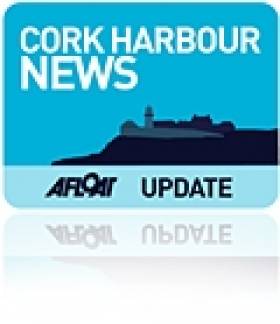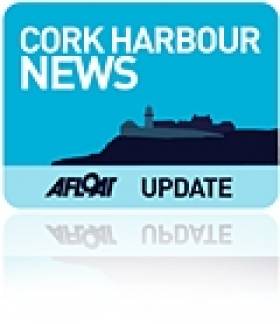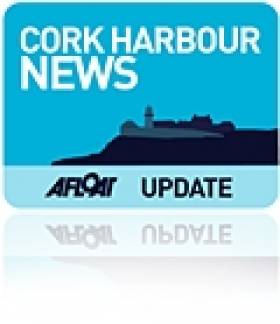Displaying items by tag: National Maritime College of Ireland (NMCI)
#nmci – The National Maritime College of Ireland (NMCI), in Cork harbour, is the lead partner in the delivery of the Canary Island's first Offshore Survival Training Centre. A ceremony to mark the partnership will be held in Las Palmas on Friday next, March 27th, hosted by Conor Mowlds, Head of the NMCI, in the presence of the Spanish Minister for Industry, Energy and Tourism, Jose Manual Soria, and Ireland's Honorary Consul in Gran Canaria, Victor Aúz Castro.
The NMCI and SEFtec, one of the world's leading suppliers of offshore simulation equipment and training support consultancy, are the lead consultants and manufacturers for the design, manufacture, development and operation of the Grupo Stier Training Centre in Las Palmas. Expertise from the NMCI and SEFtec have combined to support the development and operation of this centre and are now recognised as world leaders in the sector.
Simon Coveney, TD, Minister for Marine, Agriculture and Defence said, "This is a fantastic example of how Ireland's public and private maritime sectors can work together to deliver manufacturing and consultancy services overseas, creating jobs and revenue for the country and promoting Irish niche-sector expertise on a global platform."
Grupo Stier, who will operate the Offshore Survival Training Centre, have had a presence in the Canary Islands since 1994. Its training arm, Centro de Estudios Marítimos del Atlántico (CEMA) offers practical and innovative training for the next generation of maritime professionals based on the island. For over 20 years CEMA has developed and delivered various programmes, and activities, with an emphasis on maritime studies. The company has trained more than 2,500 alumni from all over the world.
"This project is one of the most exciting we have been involved in, the professionalism and focus of the Group Stier Team is truly impressive and the location of the Training Centre is unequalled. We have committed the full resources and expertise of the NMCI in support of this fantastic initiative and we are proud to be associated with both Group Stier and the Canary Islands" says Conor Mowlds, Head of the NMCI (& MD SEFtec NMCI Offshore Ltd.)
"The NMCI is to the fore in maritime research in Ireland, making it a global leader," said Sean Sherlock, TD, Minister of State for Development, Trade Promotion and North-South Co-operation at the Department of Foreign Affairs.
"Our goal is to further develop a thriving maritime economy, enabling economic growth and creating jobs in our ocean economy. The work of the NMCI complements that goal. Projects like this in the Canary Islands strengthen international bonds and relationships that will lead to even further advancement in the years to come."
The Centre will be located in the Puerto de Taliarte, on land leased to it through a co-operation agreement with the Cabildo de Gran Canaria: it will be completed by April and fully operational by September 2015 providing approved offshore survival training in support of the Canaries growing offshore industry.
Ida Stier, CEO Grupo Stier said: "After 20 years providing training services in the shipping market, Grupo Stier is very excited to develop this project with the support of NMCI, SEFtec and the Cabildo/City Hall de Gran Canaria, as this will give the opportunity to train local people for the offshore business and will contribute to the Islands in the development of the offshore industry."
"It is always exciting to work with ground breaking companies who are willing to introduce new products and services" said Darren O'Sullivan, Director SEFtec, "It is my strong belief that the Canaries and the Oil gas sector will benefit greatly from Grupo Stiers investment and vision"
'Open Day' at National Maritime College of Ireland
#NMCIopenday - An 'Open Day' at the National Maritime College of Ireland (NMCI) is to held on Tuesday, 22 October 2013 between 10:00 to 15:00hrs.
Representatives from international shipping companies and maritime organisations will be available to provide information about careers in the maritime industry.
These companies provide employment and sponsorship to students undertaking courses offered by the National Maritime College of Ireland. Throughout the day there will be tours of the state of the art training facilities at the college including the multi-million euro ship simulators, sea survival centre and engineering workshops.
Presentations by the maritime companies of their career opportunities.
An events' hall to visit international maritime companies and organisations.
Presentation for schools and students on course opportunities at the NMCI.
Enquiries and group bookings: Tel: (021) 433 5607. E-mail: [email protected] National Maritime College of Ireland, Ringaskiddy, Co Cork. For more about the NMCI visit: www.nmci.ie
Grand Concert to be Aired In former Church
#GrandConcert- Musicians at the dawn of their careers, are to join some of the most experienced performers in Ireland, next Thursday (24 January) in the National Maritime Museum of Ireland, once a place of worship for Church of Ireland parishioner's in Dun Laoghaire.
Performers are Norah O'Leary On Cello – Brahms, Bach and Massenet
On Song -Soprano – Sophie O'Carroll and Tenor – Phillip Scott, Thomas Moore and Gershwin Caro Mio Bene, I hear you calling me, Kerry Dance at the Midnight Hour – Someone to watch over me.
EvelinaNdlovu – On Piano- 3 Argentine Dances Flute Quartet
Two pieces by George Gershwin:
Oh, Lady Be Good, Sweet and Low Down, Easy Winners – Scott Joplin
Overture to The Marriage of Figaro
"Scherzo" from "A Midsummer Night's Dream" Felix Mendelssohn
The Grand Concert starts at 7.30pm, where an admission of €10.00 is payable at the door.
Road, Rail or ‘Sail’ to Cobh
There's also the option of departing Cork-city centre to Cobh by taking an excursion on the River Lee on the passenger-tender Spirit of the Isles. Sailings depart the city's Penrose Quay, which is on the same side to the railway (Kent) station.
Sailings will operate this Saturday and Sunday and for the remaining weekends throughout September. The boat's Saturday schedule departs the city at 11am and arrives at Cobh's Kennedy Quay at 12.15pm.
In addition there is a Lower harbour tour off Cobh on Saturdays and Sundays, departing Kennedy Pier, Cobh - 12.30pm and returning to Kennedy Pier at 1.45pm. The boat then departs Cobh at 2pm to return to Cork with an arrival time of 3.15pm. For both this Saturday and Sunday sailing schedules, fares and further information go to www.corkharbourcruises.com
In the late 1980's the Spirit of the Isles then named Ingot operated excursions for several seasons from Dun Laoghaire's East Pier to Dalkey Sound and Killiney Bay.
Returning to the third annual Cork Harbour Open Day there will also be a free shuttle-service running in the lower harbour calling at Ringaskiddy, Monkstown, Cobh, Aghada and Crosshaven. The fast-ferry RIB operator 'Whale of a Time' is providing the free service which is sponsored by the Port of Cork Company and National Maritime College of Ireland (NMCI). For further information visit http://www.whaleofatime.net/Home.html
- Dun Laoghaire
- Cork Harbour
- port of Cork
- Cruise Liners
- River Lee
- Cork Harbour Open Day
- NMCI
- Cobh Cruise Terminal
- National Maritime College of Ireland (NMCI)
- Ports and Shipping News
- Cork Harbour News
- Irish Rail
- Port of Cork Company
- Cunard Line
- Queen Elizabeth
- Whale of a Time
- Cruise Liner news
- Dalkey Sound
- Cruise ship news
- Midelton Food & Drink Festival
- Ingot
- Killiney Bay
- Irish passenger excursion vessels
- Cork Harbour Cruises
- CorkCobh
- Cork (Kent) station
- Spirit of the Isles
Take a View From the Bridge
In the evening the Cork Corona Film Festival will hold a fundraiser themed the 'Amazing Cork Maritime Experience' at the NMCI from 5pm onwards.
Also in Ringaskiddy, at the Deepwater Quay, Fastnet Lines' 22,000 tonnes Julia will be open to the public between 11am to 3pm. This will allow those to tour the facilities of the 1,500 passenger/325 vehicle capacity ferry which has operated the year round Cork-Swansea route since last year.
To enable visitors to visit the events spread across the world's second largest natural harbour, a free shuttle-ferry service connecting Ringaskiddy, Monkstown,Cobh, Aghada and Crosshaven will be operating on the day. The ferry service is sponsored by the Port of Cork Company and National Maritime College of Ireland (NMCI).
- port of Cork
- Cork Harbour Open Day
- NMCI
- Fastnet Line
- National Maritime College of Ireland (NMCI)
- Ports and Shipping News
- Cork Harbour News
- Port of Cork Company
- Ferry news
- Portsand Shipping News
- Irish nautical college
- MVJulia
- Ringaskiddy Ferry Terminal
- CorkSwansea ferry route
- Cork Corona Film Festival
'Open Day' at National Maritime College of Ireland
An 'Open Day' is to be hosted by the National Maritime College of Ireland (NMCI) on Wednesday 3 November. The Open Day is between 10-15.00hrs.
Activities include: talk on careers at sea, entry requirements to academic courses and tours of the college will be given. Prospective students will also get a chance to meet staff
and industry, who will have display stands there also.
For information about the NMCI contact Tel: (021) 497 0600 Email: [email protected] or logon to www.nmci.ie


































































